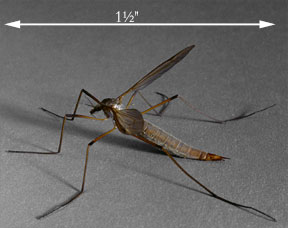|
|
|
|
Lawn
Insect Pests
-
Follow
a few simple rules to avoid most lawn damage
from pests -
|
Summary: Healthy
lawns can tolerate considerable damage from insect
pests. Proper irrigation, fertilizing and mowing
are far more important than pesticides to control
lawn pests. Follow these simple rules and prevent
most problems from lawn insects.
Jack DeAngelis, PhD
OSU Ext. Entomologist
(ret.)
|
|
Which lawn pests cause damage?
- Crane flies (right) are emerging
pests in some parts of the US and can be
particularly damaging to newly planted lawns.
Crane fly larvae feed on grass roots during cool
parts of the year and can kill large patches of
lawn as temperatures rise and the soil dries
out, see Crane
Flies for identification and control of
these lawn pests.
|
 |
European crane fly adult
~ 1-1/2 inch long.
|
|
|
- Mole crickets are lawn pests
mainly in the warm, humid southeastern states.
They burrow in the soil making characteristic
raised bumps on the soil surface. This burrowing
causes physical damage to soil and lawns, see Mole
Crickets for identification and control
guidelines.
- The larvae of lawn moths feed
at the soil surface on grass stems and leaves. A
few moths/larvae are generally no reason for
concern if the lawn is otherwise healthy (see
below).
- Chinch
bugs small insects that feed above ground
on grass blades. Chinch bug damage tends to be
much more severe during dry/hot summers. If you
suspect chinch bugs take a look at out Chinch Bug page for
identification and current control information.
- Finally, and potentially the most
destructive are white grubs. These large
beetle larvae feed on grass roots causing
considerable damage and dead patches. The larvae
are the immature stage of beetles like Japanese
beetle which can also cause significant damage
as adults, see White
Grubs for control suggestions.
|
|
Lawn care "rules"
The most important thing to keep in mind
is: healthy lawns can sustain and outgrow most
damage from lawn pests. This means that by
following a few simple rules you can avoid most
lawn pests and diseases without using
pesticides. The three most important rules
for successful home lawn care are:
(1) Don't over water or over fertilize
- grass will be more susceptible to insects and
disease if forced to grow too quickly. Allow grass
to go through a natural wet/dry cycle between
irrigation. Or, simply stop watering in early summer
and allow grass to go dormant during the dry months.
Most lawns need far less fertilizer
than they get each year. The excess fertilizer runs
off and pollutes rivers and lakes or forces the
grass to grow too fast making it susceptible to lawn
pests. Established lawns only need a light
application of fertilizer twice a year in the spring
and fall.
|
|
(2) Test the soil at least every 5
years and add lime and micro-nutrients as
needed. This is probably the most overlooked
aspect of lawn care. Check with your local
Cooperative Extension office (google "your state
name"+"your county name"+"Extension" for the
office in your county) about where you can get
your soil tested locally for a small fee. Yearly
applications of lime (dolomite lime,
not hydrated lime) are needed in many areas
in addition to micro-nutrients.
(3) Mow at the proper height for
your grass type but most importantly don't
cut the grass too short. Many turf
managers mow at the highest setting possible for
their equipment. Your grass needs some leaf
surface (grass blades) in order to be healthy!
If you follow these simple guidelines
your grass can resist damage from many insect
pests and diseases without using insecticides or
fungicide. Plus, if an insect pest or disease does
creep in, the lawn will be healthier to begin with
and it will be easier to treat the problem.
|
|
|
Don't forget to bookmark us for next time - press
ctrl-D in most browsers.
|
|
|
|
Mission: To provide accurate, up-to-date and
unbiased information for solving common insect and
mite problems around your home, business and landscape
using least-toxic methods.
Please see the Disclaimer
statements as well.
|
|
|
|
Copyright © 2004-...
LivingWithBugs, LLC. All rights reserved.
|

